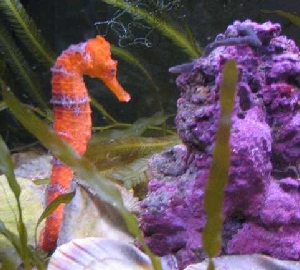Seahorses are very social animals and should be kept in pairs or groups.
Common Names: Reidi, Colored, longsnout, Brazilian, slender seahorse
Order: Syngnathiformes (Seahorses and pipefishes)
Family: Syngnathidae, subfamily Hippocampinae
Origin: Western Atlantic, North Carolina, Bermuda and Bahamas to Rio de Janeiro, Brazil.
Main Ecosystem: Marine
Salinity: 1.020*1.025
Temperament: docile
Diet: Carnivore, feeds mainly on inverts.
Care: Varied diet to consist of mysid shrimp, daphnia, grass shrimp or fish fry. They will also feed on amphipods found in your tank. Captive bred horses are usually trained to take frozen mysid and I would encourage everyone to buy captive bred horses. There are more and more captive bred horses now and they have a better survival rate than wild caught specimens. Feed daily, or at least six days a week. Several small meals a day is best. A tall tank of around 24″ is best suited for these horses. Also, they are very social animals and should be kept in pairs or groups. The pairs do not need to be male/female but they do better with company. Have plenty of hitching areas for them to hang onto. Fake plants, branching corals, nylon rope, macro algae, pipes are all good choices. They have a tendency to adopt the colors of their surrounding so brightly colored items will help enhance their colors. Pristine water is a must. Stable temps are important as seahorses are not tolerant of sharp changes in their environment. Temperatures shouldn’t fluctuate more than 2 degrees in a 24hr period. Seahorses are not suited for the reef environment or community fish system. They can’t compete for food with other quicker fishes. Compatible tank mates could consists of similar species like pipefishes as well as inverts such as shrimps, small crabs, bivalves, gastropods, non toxic cucumbers, gorgonians, sponges, snails, fan worms, brittle/serpent starfish and hermit crabs. Some fish that may work would be watchman gobies, jawfish and dragonets.
ph: 8.1-8.4
Temperature: 72-78
Potential size: 6-7″
Water Region: Tropical
Activity: diurnal
Lifespan: 5-6 yrs
Color: yellow, red, orange, white, black, some with speckling and banding.
Mouth: long tubular mouth
Sexing: Males have a noticeable pouch.
Acclimation:
Drip method is best as it gives the horses plenty of time to adjust to the new water. Being sensitive to changes, it’s important to allow them this time. It’s equally important to be sure the temperatures are exact before transferring your new horses to the tank. Keep aquarium lights off while acclimating and for a few hours after to give the horses some settling in time. It’s also a good idea to not have bright lights on in the room that your horses are being acclimated in.
Breeding:
Reidi horses have been successfully bred in captivity for several years and are relatively easy with a bonded pair. However, there is no guarantee a pair will bond. They are monogamous. They become sexually active at 7-8mo of age. The male broods the eggs and the average brood size is 200. This will vary depending on size and age of parents.
When the pair is ready to breed, they will court each other by dancing. The male will displaying his pouch to the female to show he is ready to accept the eggs. The pair will change colors while they dance around ducking their heads and entwining their tails, swimming together. They will court this way for several days til the eggs are ready. The eggs are transferred into the males pouch for brooding during the mating dance. Once pregnant, the male may become less active and less social, even ignoring food so treats may be offered to encourage him to eat. Premature birth isn’t unusual with the first broods. Gestation is around 14-28 days. Cover any intakes on pumps and filters with sponges or nylon to protect the newborn fry. Once they are born, remove the fry and place them into a rearing tank. It’s not likely the parents will eat them but it is possible. When moving the fry, don’t expose them to air so netting isn’t an option. Using a small cup or container to catch them works fine. As does sucking them into a turkey baster. Alternatively, you could also move the male into a birthing tank a few days before the fry are due, then move him back to the main tank after. The fry can then be fed baby brine shrimp, rotifers, cyclops-eeze and/or copepods.
Sources:
wetwebmedia.com
fishbase.org
seahorse.org
DracoMarine

